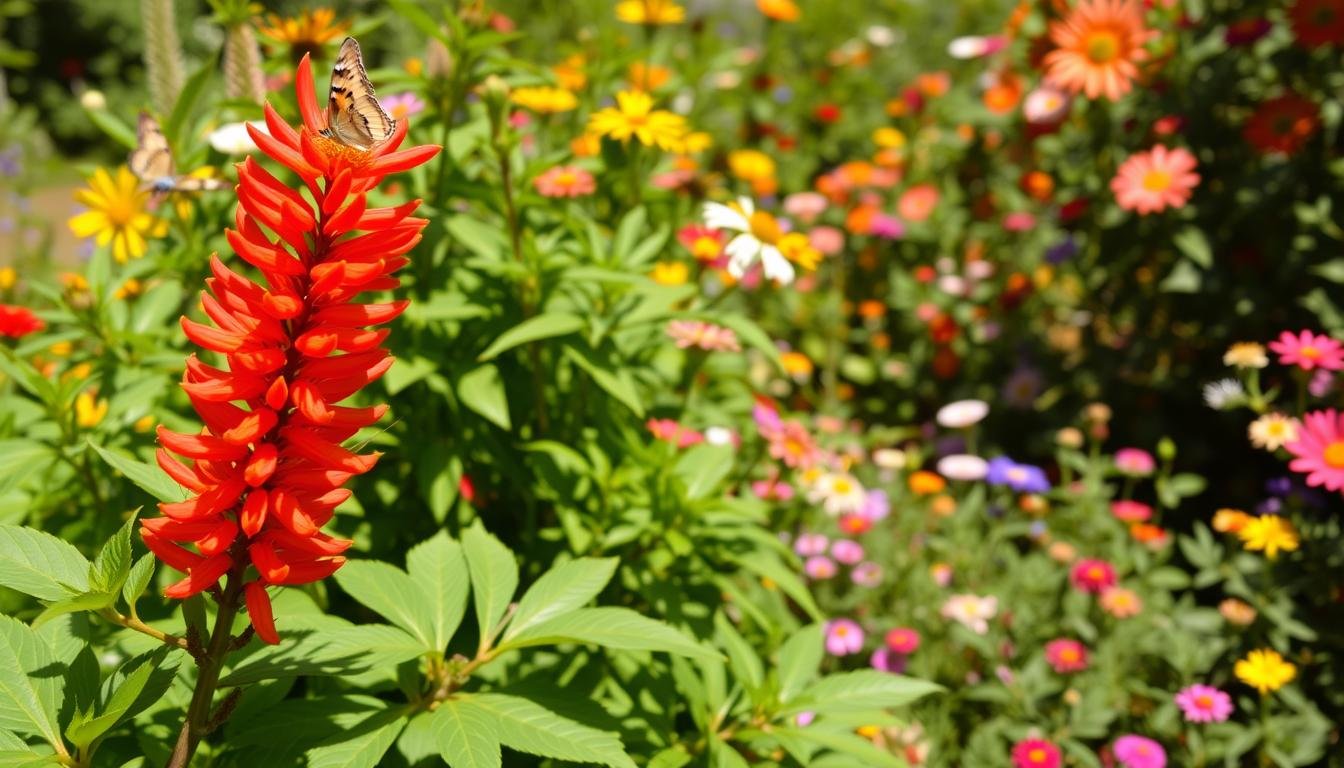The firecracker plant, Russelia equisetiformis, is a stunning addition to any landscape. It offers beauty and practicality. This perennial evergreen produces captivating tubular flowers that attract hummingbirds and butterflies.
It thrives in various environments, from sunny gardens to container setups. Many garden enthusiasts are drawn to this remarkable species. Native to Mexico and Guatemala, the firecracker plant is celebrated for its drought tolerance.
This makes it an excellent choice for low-maintenance landscaping. Whether you’re looking to add color or attract local wildlife, incorporating the firecracker plant into your garden is a decision you’re likely to appreciate for years to come.
Table of Contents
Introduction to the Firecracker Plant
The firecracker plant (scientific name: Russelia equisetiformis) is a standout in gardens. Its bright red flowers and cascading growth add a lively touch. It’s loved for its ability to fit into both classic and modern gardens.
This plant grows quite tall, reaching 3 to 5 feet. It can spread from 6 to 12 feet wide. Its flowers bloom all year, making it perfect for adding color to your outdoor space.
The firecracker plant loves warm climates, thriving in zones 9B through 11. It’s great in hot areas because it can handle drought and attracts pollinators. It grows fast, creating lush areas in your garden but might need some control.
It’s important to match this plant with your garden’s needs. It needs full sun to bloom well. Plant them 36 to 60 inches apart for good air and growth. It grows well in many soils and can handle some salt, making it adaptable.
In short, the firecracker plant is not just beautiful but also good for your garden and local wildlife. It’s a great choice for anyone who loves gardening.
What is the Firecracker Plant?
The firecracker plant, known as Russelia equisetiformis, is a beautiful shrub. It’s loved for its lush look and bright flowers. This plant grows fast, reaching 3 feet tall and spreading 3 to 5 feet wide.
Its weeping branches cascade beautifully, adding charm to any landscape. This makes it a great choice for garden designs.
Botanical Classification
The firecracker plant is part of the Russelia genus. It honors Scottish naturalist Alexander Russell. These plants are known for growing well in different places and loving the sun.
They are closely related to the Scrophulariaceae family. This shows their unique place in the botanical world.
Common Names and Variations
This plant is also called the coral fountain, coral plant, or fountain plant. These names show its bright colors and flowing growth. There are many variations of Russelia equisetiformis to choose from.
Each one has its own special traits, colors, or growth patterns. This makes it a favorite among garden lovers.
| Common Names | Scientific Name | Key Characteristics |
|---|---|---|
| Coral Fountain | Russelia equisetiformis | Weeping branches, abundant blooms |
| Coral Plant | Russelia equisetiformis | Brightly colored flowers, fast growth |
| Fountain Plant | Russelia equisetiformis | Cascading growth, drought tolerance |
Characteristics of Firecracker Plant
The firecracker plant is a favorite among gardeners for its stunning features. Its vibrant flowers and growth habits make it charming.
Flower Color and Shape
The firecracker plant’s flowers are striking. They have a tubular shape and come in red, orange, pink, and white. Each flower is about 1 inch long, looking like a firework burst.
These firecracker plant flowers grow in clusters. They create a stunning display that attracts hummingbirds. These birds love to sip the nectar from the flowers.
Growth Habit and Size
The firecracker plant has long, arching branches. It can grow 3 to 6 feet tall, depending on the environment. This makes it versatile for your garden.
It can be a decorative shrub, a vibrant hanging plant, or a ground cover. The size of Russelia equisetiformis matches its showy flowers. This creates a lively outdoor space.
| Characteristic | Details |
|---|---|
| Scientific Name | Cuphea ignea |
| Flower Color | Red, Orange, Pink, White |
| Average Flower Size | 1 inch |
| Height | 3 to 6 feet |
| Spread | 3 feet |
| Blooming Period | Early summer to first frost |
| Pest Resistance | Very few issues |
| Watering Needs | Low to medium |
Origin and Habitat of the Firecracker Plant
The firecracker plant is known for its bright colors and unique flowers. It comes from native regions of firecracker plant in Mexico and Guatemala. These places have tropical and subtropical climates, perfect for the plant to thrive.
Knowing where the firecracker plant comes from helps us understand how to care for it. This knowledge is key to enjoying its beauty.
Native Regions
The firecracker plant, or Mina lobata, is mainly from Central and South America. It grows well in warm weather and well-drained soil. It can grow up to 20 inches tall and spread about 24 inches wide.
In different climates, its size can change. This is true when grown as an annual or indoors during winter. The plant’s ability to adapt to various environments is impressive.
Preferred Growing Conditions
To grow the firecracker plant, knowing its preferred growing conditions is important. It loves full sun to partial shade, which helps it bloom. It prefers moist soil but not too wet, as it can harm the plant.
The firecracker plant also does well in city gardens. It’s good for zones 9 to 11, where it gets the warmth and humidity it needs.
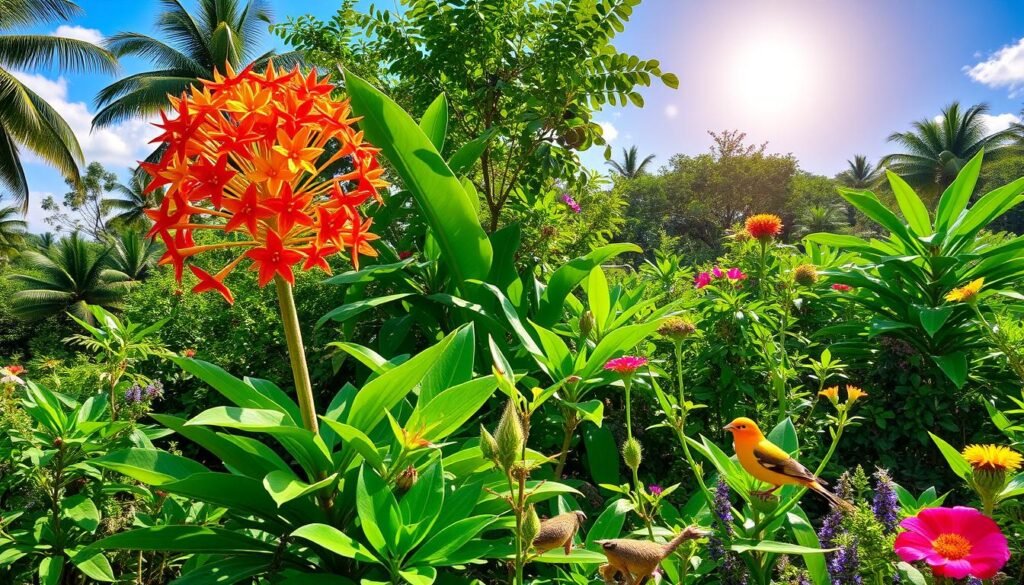
| Growing Conditions | Description |
|---|---|
| Soil Type | Well-draining sandy loam |
| Sunlight | Full sun to partial shade |
| Moisture | Average to evenly moist, avoid standing water |
| Hardiness Zones | 9 to 11 |
| Pest Tolerance | Somewhat tolerant of urban pollution |
By matching your garden to the firecracker plant’s needs, you can make it more beautiful and hardy. For more gardening advice, check out growing hydroponic plants.
Why You Should Grow Firecracker Plant
The firecracker plant is not just pretty for your garden. It also has practical benefits. It’s great for saving water and attracting pollinators. This makes it a great choice for gardeners who care about the environment and beauty.
Drought Tolerance
Once it’s settled, the firecracker plant is very good at handling drought. It’s perfect for saving water. While it does better with regular watering, it can survive with little water.
It can grow up to 3-5 feet tall and 5-6 feet wide. It shows off its bright flowers all year, no matter the weather.
Attraction for Pollinators
The firecracker plant draws in hummingbirds and butterflies with its flowers. Its long, tubular flowers are a hit with pollinators. They love the sweet nectar it offers.
Adding this plant to your garden helps local wildlife. It makes your garden more diverse and welcoming to nature.
Preferred Light Conditions for Firecracker Plant
The firecracker plant needs specific light to grow well. It thrives in full sun for at least six hours a day. This ensures vibrant blooms and dense foliage.
In partial shade, it can adapt, but it does best in bright sunlight. This is true, even in hotter climates.
For indoor plants, place them near south-facing windows. This maximizes light and boosts health. The right light also helps fight pests and diseases.
The firecracker plant’s light needs can change with the environment. But, it always needs bright light. Proper lighting leads to a beautiful garden that lasts all year. For more gardening tips, check out this useful resource.
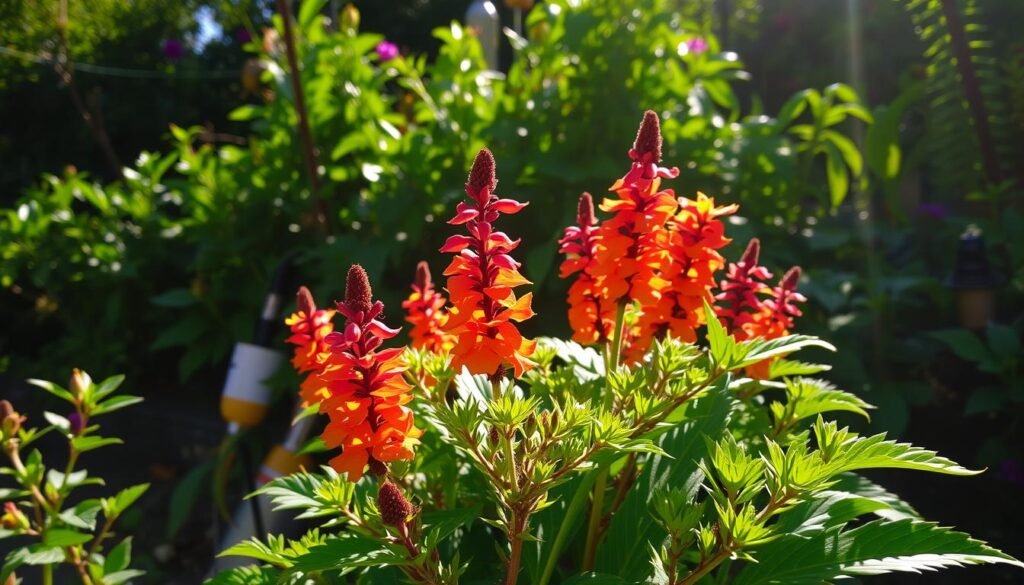
Soil Requirements for Firecracker Plant
The firecracker plant, known as Russelia equisetiformis, needs specific soil to grow well. Knowing the right soil types and pH levels is key for your plants to thrive.
Soil Types
Firecracker plants can grow in different soils. To help them grow best, use well-draining soil. Good options include:
- Sandy Soil
- Loamy Soil
- Clay Soil (with proper amendments)
Adding compost to your soil makes it better for plants. It helps with drainage and gives plants the nutrients they need. This leads to healthy roots and plants.
pH Level Considerations
The best pH for firecracker plants is between 5.8 and 6.5. Keeping the soil pH right helps plants absorb nutrients. Test your soil pH often and adjust it if needed.
Here’s a quick guide to what firecracker plants need:
| Requirement | Details |
|---|---|
| Soil Type | Sandy, Loamy, Clay (well-drained) |
| Drainage | Excellent, to prevent waterlogging |
| Organic Matter | Compost recommended |
| pH Level | 5.8 – 6.5 (mildly acidic to neutral) |
Watering Guidelines for Firecracker Plant
Knowing how much water your firecracker plant needs is key to its health. Proper watering is important, both when it’s new and when it’s grown. It will help your plant thrive in your garden.
Initial Watering Needs
When your firecracker plant is new, it needs regular, deep waterings. Water it once a week, letting the top soil dry out before the next watering. For a potted firecracker, use about 0.5 cups of water every 9 days, unless it’s in direct sunlight.
This consistent watering helps the roots grow strong.
Maintenance Watering After Establishment
After your firecracker plant is settled, it can handle dry spells well. But, it’s good to water it sometimes during long dry periods. Check the soil moisture often to keep it healthy.
Make sure water drains well to prevent root rot. This is a common problem from too much water.
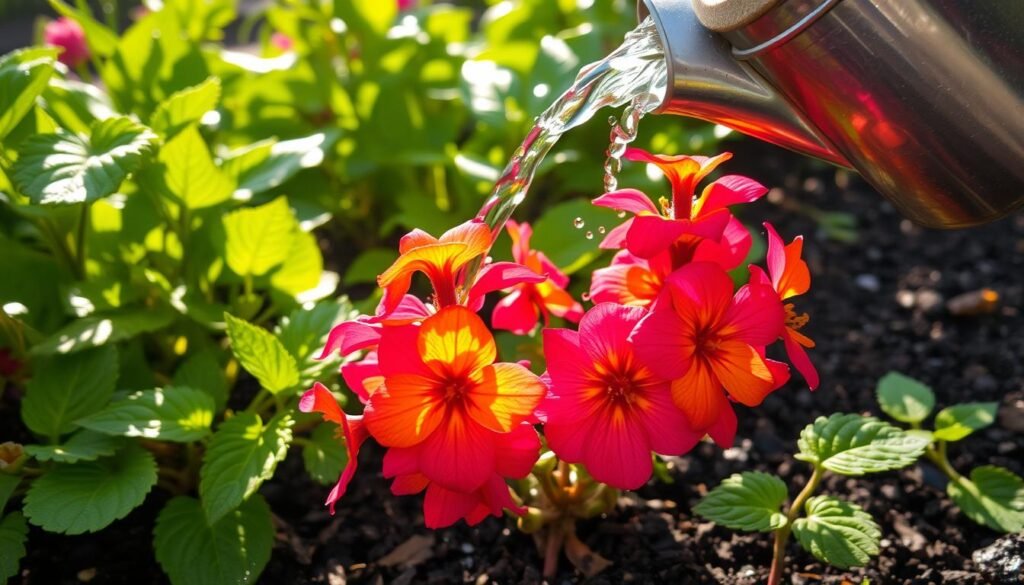
Fertilization Needs of Firecracker Plant
Fertilizing your firecracker plant is key to its growth and beauty. Use a balanced, slow-release fertilizer every month during the growing season. This helps with bright blooms and keeps the plant healthy. Make sure to check the nitrogen, phosphorus, and potassium levels in the fertilizer.
Deciding between liquid and granular fertilizers matters. Liquid fertilizers need more frequent use but can be diluted. Granular fertilizers are easier to apply but less often. Watch for signs like yellow leaves or slow growth if you think you’re over-fertilizing. Adjust your fertilizer use if needed.
When to fertilize is important. Apply during the growth and blooming seasons. This ensures your plant gets the nutrients it needs. As winter comes, reduce fertilizing because the plant’s needs drop. This care will keep your firecracker plant colorful and lively in your garden.
For more tips and products, check out this resource.
Pruning and Maintenance Practices
Caring for your firecracker plant means regular firecracker plant pruning. This keeps it healthy and vibrant. Just a little pruning can make your garden look amazing. The right maintenance practices for Russelia lead to a fuller, more colorful plant.
Timing for Pruning
Prune your firecracker plant in late winter or early spring. This is right before new growth starts. It helps remove dead or damaged branches, promoting healthy growth.
Proper care during this time boosts your plant’s resilience. By following these practices, you’ll see a lush display of vibrant flowers all season.
Adding the right fertilization and watering to your pruning routine helps your plant’s health. For more gardening tips, check out resources on caring for different plants.
Propagation Methods for Firecracker Plant
Learning about firecracker plant propagation can make gardening more fun. Propagating from seed is slow and not very effective. Seeds can take years to grow and bloom, which is not ideal for quick results. Try cuttings or division for faster growth.
Seed Propagation
Seed propagation requires patience. Plant seeds in a mix of peat and perlite. Keep the area warm and humid to help seeds grow. But, you might find other methods more rewarding for quicker blooms.
Cuttings and Division
Cuttings and division are the best ways to grow firecracker plants. For cuttings, use 4-6 inch long stems. Put them in a mix of peat moss and perlite. Roots will start to show in 2-3 weeks, and a full plant in 4-6 weeks.
Division gives you instant results. Just split a mature plant into sections and replant. They’ll settle in 1-2 weeks. Both methods need careful attention. Make sure your plants get enough light and don’t overwater. For more tips, check out this resource.
Best Time to Plant Firecracker Plant
To get the most vibrant blooms, timing is key for planting your firecracker plant (Russelia equisetiformis). Late winter to early spring is the best time. This lets the roots grow strong before summer heat hits.
Planting during this period sets your firecracker plant up for success. As the weather warms up, it will bloom more brightly. In USDA zones 9a to 11b, these plants do best with the right start.
Planting at the right time helps avoid stress from drought and heat. For more on firecracker plant care, visit here.
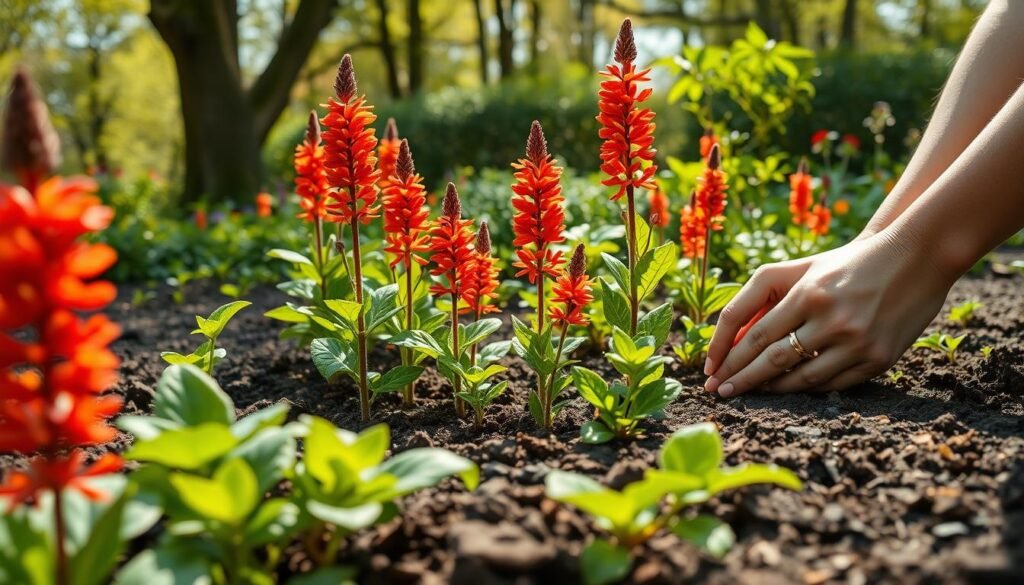
| Planting Period | Benefits |
|---|---|
| Late Winter to Early Spring | Establish roots before heat; enhances growth |
| Summer | Vibrant flowering season; attracts pollinators |
Conclusion
Adding a firecracker plant to your garden brings many benefits. It adds color and attracts pollinators, making your garden healthier. This plant is easy to care for, so you can enjoy its beauty without stress.
When you start growing a firecracker plant, you’ll find it’s tough and can grow in different soils. This summary will help you keep it healthy with the right care. Watch out for pests and use good control methods to keep your plant thriving.
The firecracker plant is a beautiful addition to any garden. It looks great in borders, containers, or mixed beds. It makes your outdoor space more beautiful and helps the environment. Let the firecracker plant make your garden vibrant and full of life!

